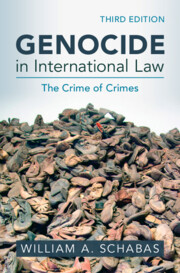Book contents
- Genocide in International Law
- Genocide in International Law
- Copyright page
- Dedication
- Contents
- Preface to the First Edition
- Acknowledgements
- Abbreviations
- Introduction
- 1 Origins of the Legal Prohibition of Genocide
- 2 Drafting of the Genocide Convention
- 3 Subsequent Normative Developments
- 4 Groups Protected by the Convention
- 5 The Specific Intent to Commit Genocide
- 6 Punishable Acts of Genocide
- 7 Cultural Genocide, Ethnic Cleansing and Other Acts Not Punishable under the Convention
- 8 ‘Other Acts’ of Genocide
- 9 Defences to Genocide
- 10 The Duty to Punish Genocide
- 11 Prosecution of Genocide by International Criminal Tribunals
- 12 State Responsibility and the Role of the International Court of Justice
- 13 Prevention of Genocide
- 14 Activity of International Organizations
- 15 Treaty Law Questions and the Convention
- Conclusions
- Bibliography
- Index
1 - Origins of the Legal Prohibition of Genocide
Published online by Cambridge University Press: 14 March 2025
- Genocide in International Law
- Genocide in International Law
- Copyright page
- Dedication
- Contents
- Preface to the First Edition
- Acknowledgements
- Abbreviations
- Introduction
- 1 Origins of the Legal Prohibition of Genocide
- 2 Drafting of the Genocide Convention
- 3 Subsequent Normative Developments
- 4 Groups Protected by the Convention
- 5 The Specific Intent to Commit Genocide
- 6 Punishable Acts of Genocide
- 7 Cultural Genocide, Ethnic Cleansing and Other Acts Not Punishable under the Convention
- 8 ‘Other Acts’ of Genocide
- 9 Defences to Genocide
- 10 The Duty to Punish Genocide
- 11 Prosecution of Genocide by International Criminal Tribunals
- 12 State Responsibility and the Role of the International Court of Justice
- 13 Prevention of Genocide
- 14 Activity of International Organizations
- 15 Treaty Law Questions and the Convention
- Conclusions
- Bibliography
- Index
Summary
The post-First World War minorities treaties regime was an initial attempt by international law to address the rights of national and ethnic minorities. Its shorcomings prompted Raphael Lemkin, in his book Axis Rule in Occupied Europe, to propose a new category of international crime that he named genocide. The International Military Tribunal prosecuted acts of genocide using the category of crimes against humanity. Several of the defendants were convicted of acts aimed at destruction of Europe’s Jewish population. However, crimes against humanity were confined to acts associated with aggressive war. At the first session of the United Nations General Assembly in 1946, a resolution on genocide was proposed in order to address the peacetime atrocities that were neglected in the Nuremberg judgment. The resolution recognized genocide as an international crime and called for preparation of a convention.
Keywords
- Type
- Chapter
- Information
- Genocide in International LawThe Crime of Crimes, pp. 14 - 42Publisher: Cambridge University PressPrint publication year: 2025

